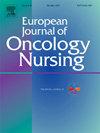Exploration of symptom cluster patterns and their trajectory in esophageal cancer surgery patients
IF 2.7
3区 医学
Q1 NURSING
引用次数: 0
Abstract
Purpose
To investigate symptom burden and symptom cluster trajectories in patients undergoing surgery for esophageal cancer.
Methods
A convenience sample of 210 patients who underwent thoracoscopic surgery for esophageal cancer was included from July to December 2023. The symptoms of the patients were evaluated at the following time points: preoperatively (T0), 1–3 days postoperatively (T1), 7 days postoperatively (T2), 1 month postoperatively (T3), and 3 months postoperatively (T4). This was done via the Chinese version of the MD Anderson Symptom Scale and the Supplementary Questionnaire for Perioperative Esophageal Cancer Symptoms. Exploratory factor analysis was used to identify symptom clusters, and latent class growth modeling was used to analyze the trajectories of each different symptom cluster.
Results
Exploratory factor analysis revealed the presence of four symptom clusters: mood-related symptom clusters (worst at T1, T2, and T4), gastrointestinal symptom clusters (worst at T0), fatigue-related symptom clusters (worst at T3), and surgery-related symptom clusters, with cumulative variance contribution rates of 64.34%, 62.29%, 68.23%, 70.29%, and 63.82%, respectively. The latent category growth model identified the existence of 2–3 distinct trajectories in each symptom cluster.
Conclusion
This study identified 4 distinct symptom clusters in patients undergoing esophageal cancer surgery. The mood-related and gastrointestinal symptom clusters exhibited worsening and recurrence within 7 days post-surgery, necessitating particular attention. A subset of patients in the fatigue-related symptom cluster showed a tendency for continued exacerbation, emphasizing the need for long-term monitoring. Furthermore, symptom management strategies can be prioritized based on the severity of the symptom clusters.
求助全文
约1分钟内获得全文
求助全文
来源期刊
CiteScore
4.40
自引率
3.60%
发文量
109
审稿时长
57 days
期刊介绍:
The European Journal of Oncology Nursing is an international journal which publishes research of direct relevance to patient care, nurse education, management and policy development. EJON is proud to be the official journal of the European Oncology Nursing Society.
The journal publishes the following types of papers:
• Original research articles
• Review articles

 求助内容:
求助内容: 应助结果提醒方式:
应助结果提醒方式:


